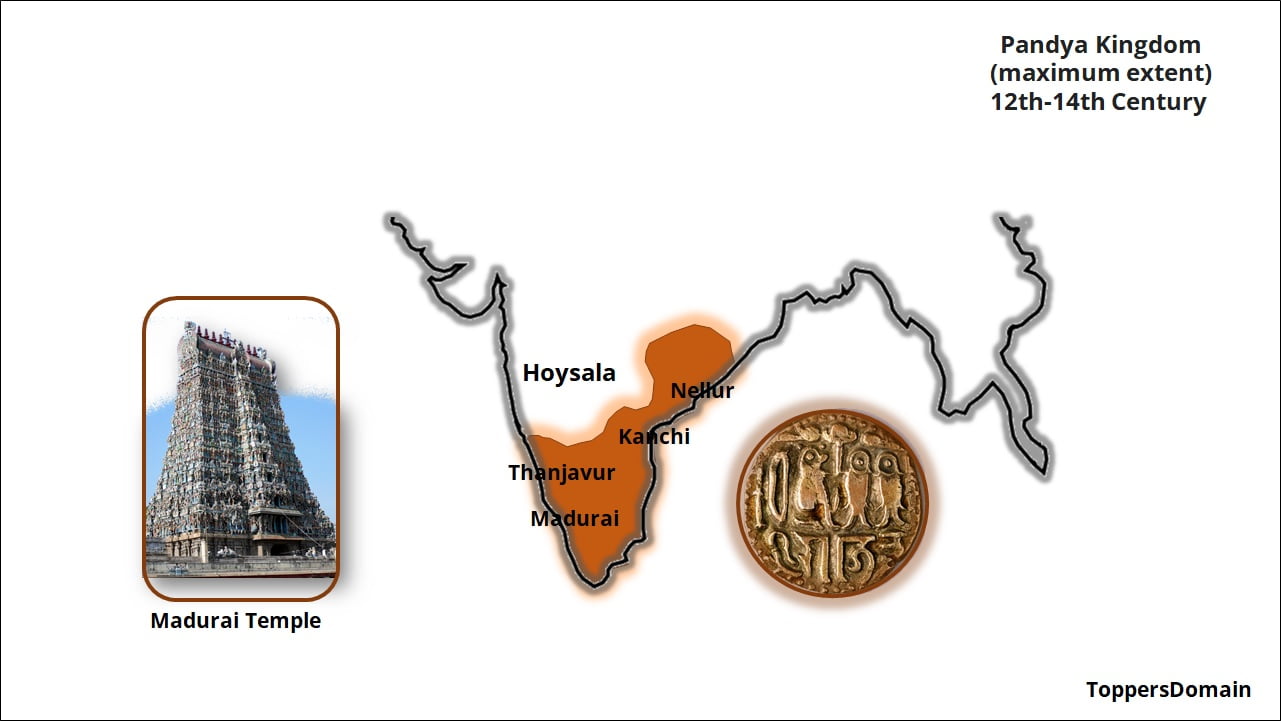Pandyas: Polity, Society, Economy and Culture
History
- Language
Index
Introduction
The Pandya Kingdom, also known as the Pandya Empire, was a distinguished dynasty that ruled over the southern part of India during the classical period. From the 3rd century BCE to the 14th century CE, the Pandyas played a significant role in shaping the political, cultural, and economic landscape of South India. Their reign left a lasting impact that continues to influence the region to this day.
Geographical Expansion: A Vast Empire
The Pandya Kingdom spanned the southernmost regions of the Indian subcontinent, encompassing present-day Tamil Nadu, parts of Kerala, and even extending its reach to Sri Lanka. This expansive territory granted the Pandyas control over major trade routes and facilitated their establishment of lucrative maritime trade with distant lands. From the southern tip of the peninsula to the banks of the River Tungabhadra in the north, and from the Arabian Sea in the west to the Bay of Bengal in the east, the Pandya Kingdom was a force to be reckoned with.
Political Structure: Monarchy and Hereditary Succession
At the helm of the Pandya Kingdom stood a monarchy, with the king wielding absolute power. The crown passed from one generation to another within the royal family through a system of hereditary succession. Supporting the king were a council of ministers and officials who efficiently managed the various administrative functions, ensuring the smooth functioning of the kingdom.
Cultural Significance: Patronage of Art and Literature
During the reign of the Pandyas, South India experienced a rich and diverse cultural era. The Pandyas were notable patrons of literature, art, and architecture, and their rule witnessed the flourishing of Tamil literature. One of the most celebrated Tamil epics, the "Silappatikaram," was composed during this period, showcasing the Pandyas' support for the arts. The dynasty also made significant contributions to the development of temple architecture, with the Meenakshi Temple in Madurai serving as a prominent example of their grand architectural legacy.
Religious Influence: Devotion to Hinduism
Religion played a vital role in the Pandya Kingdom, with Hinduism being the predominant faith. The Pandyas were staunch devotees of Lord Shiva, and many temples dedicated to Shiva were constructed under their patronage. Alongside the worship of Lord Shiva, reverence for deities like Murugan, Vishnu, and the Mother Goddess prevailed throughout the region. Jainism and Buddhism also had a presence in the Pandya Kingdom during this period, reflecting the religious diversity of the time.
Economic Prosperity: Agrarian Society and Maritime Trade
The Pandya Kingdom's economy thrived on agriculture, which served as the backbone of society. The fertile plains of the region supported the cultivation of rice, millets, sugarcane, and cotton, ensuring the prosperity of the kingdom. The Pandyas implemented advanced irrigation systems, constructing reservoirs and canals that facilitated agricultural practices and improved the overall productivity of the land. Furthermore, the Pandyas engaged in extensive trade and commerce, capitalizing on their strong maritime presence. They established trade connections with the Roman Empire, Southeast Asia, and East Africa, exporting a wide range of goods including spices, precious stones, textiles, and other luxury items. Korkai, a bustling port city, emerged as a major center of trade, further bolstering the Pandya Kingdom's economic prowess.
Diplomatic Relations: Collaboration and Alliances
The Pandyas maintained diplomatic relations with various kingdoms and e mpires, forging alliances when necessary to counter external threats. They actively participated in regional politics and fostered relationships with neighboring dynasties such as the Cholas, Cheras, and Pallavas. Furthermore, the Pandya Kingdom established trade links with the Roman Empire, contributing to the prosperity of both regions.
Conclusion: A Lasting Legacy
In conclusion, the Pandya Kingdom was a powerful dynasty that held sway over the southern part of India, stretching across present-day Tamil Nadu, parts of Kerala, and Sri Lanka. Their reign witnessed remarkable achievements in art, literature, and temple architecture. The Pandyas fostered trade and commerce, and their kingdom was characterized by agricultural prosperity and maritime trade. The enduring legacy of the Pandyas continues to shape the culture and history of the region to this day.
Share
Other Topics
Unit - III


